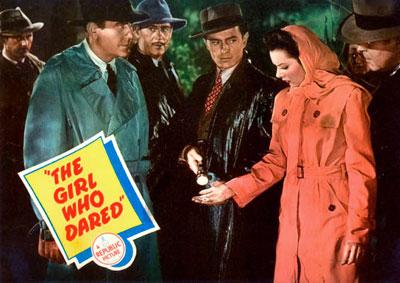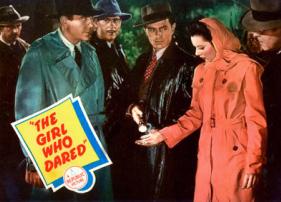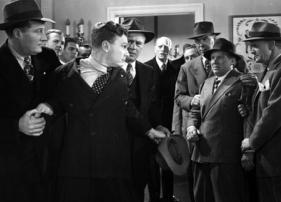Directed by Howard Bretherton
Republic Pictures Corp. Screenwriter: John K. Butler. Based on the novel by Medora Field. Cinematographer: Bud Thackery. Editor: Arthur Roberts. With: Lorna Gray, Peter Cookson, Grant Withers, Veda Ann Borg, John Hamilton. 35mm, b/w, 56 min.
An invitation to a party at a remote old house, a succession of murders, the telephone line cut—here you have all the makings of a classic whodunit. Directed for Republic Pictures by Howard Bretherton (in a break from a seemingly incessant stream of Republic Westerns) the film briskly adapts Medora Field’s 1942 novel Blood On Her Shoe with screenwriter John K. Butler (himself a prolific author of pulp-fiction) doing the honors.
The film unspools a familiar yarn, in which murder strikes a small group of party guests at a house on an island off the coast of Georgia. The plot is strung across devices ranging from a spooky pirate shipwreck to a cache of stolen radium, and its complement of characters includes romantic rivals for the same woman, feuding twin sisters and a wide-eyed black servant (Willie Best, toiling mightily to sustain both terror and comic relief). As the mystery mounts, so does the peril: the guests’ cars are disabled, a suspicious man is seen lurking, and when a second body turns up, the various partygoers become suspects to each other, and must jointly figure out which one among them is a killer. Intrepid guest Ann Carroll (Lorna Gray, later known as Adrian Booth) undertakes to solve the mystery with the help of handsome insurance investigator Rufus Blair (Peter Cookson), and romance sparks—economically, given the running time of less than one hour! The timing was fortuitous for such a story, following not only another, similar adaptation of a Medora Field novel at Republic (1940’s Who Killed Aunt Maggie?, directed by Arthur Lubin), but also Agatha Christie’s 1939 phenomenal best-selling novel And Then There Were None, staged as a play with great success in London in 1943, and in New York by 1944, featuring many of the same plot elements.
The story bears an interesting provenance: novelist Field was a columnist for the Atlanta Journal-Constitution’s Sunday magazine, where fellow journalist Peggy Marsh (née Margaret Mitchell) found fame with her own novel also written on the side, Gone with the Wind. Probably no two colleagues’ writing careers have ever taken such divergent paths.
Shannon Kelley
Preserved in cooperation with Paramount Pictures from the 35mm nitrate original picture and track negatives. Laboratory services by The Stanford Theatre Film Laboratory, Audio Mechanics, DJ Audio.






 Mobile Navigation
Mobile Navigation



